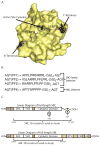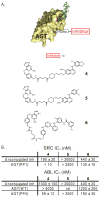Bivalent inhibitors of the tyrosine kinases ABL and SRC: determinants of potency and selectivity
- PMID: 21060940
- PMCID: PMC3268058
- DOI: 10.1039/c0mb00108b
Bivalent inhibitors of the tyrosine kinases ABL and SRC: determinants of potency and selectivity
Abstract
We recently reported a chemical genetic method for generating bivalent inhibitors of protein kinases. This method relies on the use of the DNA repair enzyme O(6)-alkylguanine-DNA alkyltransferase (AGT) to display an ATP-competitive inhibitor and a ligand that targets a secondary binding domain. With this method potent and selective inhibitors of the tyrosine kinases SRC and ABL were identified. Here, we dissect the molecular determinants of the potency and selectivity of these bivalent ligands. Systematic analysis of ATP-competitive inhibitors with varying linker lengths revealed that SRC and ABL have differential sensitivities to ligand presentation. Generation of bivalent constructs that contain ligands with differential affinities for the ATP-binding sites and SH3 domains of SRC and ABL demonstrated the modular nature of inhibitors based on the AGT scaffold. Furthermore, these studies revealed that the interaction between the SH3 domain ligand and the kinase SH3 domain is the major selectivity determinant amongst closely-related tyrosine kinases. Finally, the potency of bivalent inhibitors against distinct phospho-isoforms of SRC was determined. Overall, these results provide insight into how individual ligands can be modified to provide more potent and selective bivalent inhibitors of protein kinases.
Figures





Similar articles
-
Bivalent Inhibitors of c-Src Tyrosine Kinase That Bind a Regulatory Domain.Bioconjug Chem. 2016 Jul 20;27(7):1745-9. doi: 10.1021/acs.bioconjchem.6b00243. Epub 2016 Jun 22. Bioconjug Chem. 2016. PMID: 27266260 Free PMC article.
-
Protein conjugates of SH3-domain ligands and ATP-competitive inhibitors as bivalent inhibitors of protein kinases.Chembiochem. 2009 Oct 12;10(15):2445-8. doi: 10.1002/cbic.200900462. Chembiochem. 2009. PMID: 19731277 No abstract available.
-
A chemical genetic method for generating bivalent inhibitors of protein kinases.J Am Chem Soc. 2009 May 20;131(19):6686-8. doi: 10.1021/ja900871y. J Am Chem Soc. 2009. PMID: 19391594
-
Src protein-tyrosine kinase structure, mechanism, and small molecule inhibitors.Pharmacol Res. 2015 Apr;94:9-25. doi: 10.1016/j.phrs.2015.01.003. Epub 2015 Feb 3. Pharmacol Res. 2015. PMID: 25662515 Review.
-
Recent advances in development of hetero-bivalent kinase inhibitors.Eur J Med Chem. 2021 Apr 15;216:113318. doi: 10.1016/j.ejmech.2021.113318. Epub 2021 Feb 23. Eur J Med Chem. 2021. PMID: 33730624 Review.
Cited by
-
Examining the influence of specificity ligands and ATP-competitive ligands on the overall effectiveness of bivalent kinase inhibitors.Proteome Sci. 2017 Jul 17;15:17. doi: 10.1186/s12953-017-0125-1. eCollection 2016. Proteome Sci. 2017. PMID: 28725163 Free PMC article.
-
Targeting diverse signaling interaction sites allows the rapid generation of bivalent kinase inhibitors.ACS Chem Biol. 2012 Mar 16;7(3):487-95. doi: 10.1021/cb200387g. Epub 2011 Dec 22. ACS Chem Biol. 2012. PMID: 22148755 Free PMC article.
-
Bivalent inhibitors of protein kinases.Crit Rev Biochem Mol Biol. 2014 Mar-Apr;49(2):102-15. doi: 10.3109/10409238.2013.875513. Epub 2014 Feb 25. Crit Rev Biochem Mol Biol. 2014. PMID: 24564382 Free PMC article. Review.
-
Conversion of a Single Polypharmacological Agent into Selective Bivalent Inhibitors of Intracellular Kinase Activity.ACS Chem Biol. 2016 Jan 15;11(1):121-31. doi: 10.1021/acschembio.5b00847. Epub 2015 Nov 6. ACS Chem Biol. 2016. PMID: 26505072 Free PMC article.
-
Potent and selective inhibition of SH3 domains with dirhodium metalloinhibitors.Chem Sci. 2015 Aug 1;6(8):4778-4783. doi: 10.1039/c5sc01602a. Epub 2015 Jun 3. Chem Sci. 2015. PMID: 29142714 Free PMC article.
References
-
- Manning G, Whyte DB, Martinez R, Hunter T, Sudarsanam S. Science. 2002;298:1912–1934. - PubMed
-
- Blume-Jensen P, Hunter T. Nature. 2001;411:355–365. - PubMed
-
- Hunter T. Cell. 2000;100:113–127. - PubMed
-
- Cohen P. Nat Rev Drug Discovery. 2002;1:309–315. - PubMed
-
- Parang K, Cole PA. Pharmacol Ther. 2002;93:145–157. - PubMed
Publication types
MeSH terms
Substances
Grants and funding
LinkOut - more resources
Full Text Sources
Research Materials
Miscellaneous

